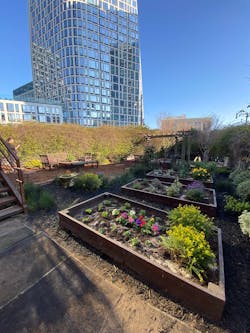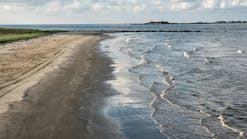San Francisco’s First Onsite Greywater Reuse Project Reveals the Future of Urban Water
Drought, aging infrastructure, and growing populations have brought our water and wastewater systems to a critical inflection point. Utility rates and water restrictions are soaring across the United States, reflecting the growing scarcity of reliable potable sources. In response, governments and real estate owners are under pressure to conserve and reuse more water. Facing the worst Western drought in 1,200 years, San Francisco is the first city in the nation to mandate onsite water reuse for new buildings above 100,000 gross square feet.
The crucial word here is “onsite.” In contrast to a typical building, where wastewater flows from the building into a network of underground pipes to the city's centralized treatment plant, each building with onsite water reuse contains a small wastewater treatment system. This system purifies wastewater and directs it toward non-potable applications including toilet flushing, irrigation, laundry, and cooling towers. By using recycled water for non-potable purposes, buildings with onsite water reuse reduce their potable water use by up to 95% In residential high-rises, this can translate to millions of gallons of water -- and hundreds of thousands of dollars – saved per year.
Onsite reuse also makes buildings more sustainable by conserving water resources and diversifying municipal water supplies. Since these systems create a hyper-local wastewater treatment cycle, they reduce a building’s water and sewer load on the city's piping infrastructure. They also make buildings more water-resilient by limiting reliance on that piping. Extreme weather, hydraulic capacity constraints, combined sewer overflows, and other infrastructure issues don’t affect onsite reuse systems like they do main water systems.
These benefits have led several cities and states to become onsite water reuse pioneers as they work to manage the growing water crisis. For example, beginning in 2012, San Francisco became one of the first American cities to adopt the collection, treatment, and use of alternate water sources for non-potable uses in buildings. Since then, the city has amended the ordinance to require the installation of onsite reuse systems in new construction buildings. Currently, residential buildings over 100,000 square feet must install greywater systems, and commercial buildings must install blackwater systems. This law ensures that the next few years will see onsite reuse systems installed all over the city.
Developers of these upcoming projects can look to Related California’s Fifteen Fifty Mission building for guidance. Located in the heart of downtown San Francisco and composed of 550 apartments, Fifteen Fifty boasts San Francisco’s first approved and operational onsite greywater reuse system. With the ongoing support of Epic Cleantec’s operations team, this system recycles up to 7,500 gallons of greywater per day from showers, laundry, and rainwater for non-potable reuse. By using recycled water to flush toilets and for use in cooling towers, it will save the equivalent of 20 million water bottles of municipal potable water every year and reduce the annual load on the city’s underground sewer and water pipes by close to 2.7 million gallons.
This project demonstrates that the real estate community has a pivotal role in building a more sustainable and water-secure future. As San Francisco’s first approved and operational greywater recycling system, the Fifteen Fifty project is a crucial milestone and model for urban building sustainability and resilience.
Combating the Water Crisis: the Essential Role of Water Reuse
Unfortunately, California and the Western United States’ historic drought isn’t likely to end soon. Nearly half of the U.S. suffered moderate to extreme drought this year, and globally, water scarcity impacts 40% of the world’s population.
Moreover, much of America’s water infrastructure is in sore need of repair and critical upgrades. On average, 14-18 % of the U.S.’ total potable water per day is lost through pipe leaks – in fact, a water main break occurs every two minutes. The average U.S. water pipe is 45 years old, with some dating back a century. In addition to unmet maintenance needs, much of the underground infrastructure is not designed to handle the stress of today’s more extreme climate conditions. It can buckle under heat waves, hurricanes and floods, including those California has recently suffered.
Such vulnerabilities are further exacerbated by the fact that national funding to improve water infrastructure lags behind the pressing need. Since new urban construction relies on old infrastructure, every new project heightens the risk of these old pipes getting overloaded.
These drought and infrastructure issues result in rising water rates, which challenge cities, developers, and industries alike. To manage limited water resources, a growing number of cities including San Francisco, Los Angeles, San Antonio, and Austin are mandating or incentivizing onsite water reuse regulations for large buildings. As leaders across the country continue to recognize its potential, multiple states including Washington State, Colorado, Hawaii and California have implemented voluntary onsite water recycling policies.
By decentralizing treatment, onsite water reuse lets buildings comply with these new regulations and improves access to water in cases of centralized water system failure and more frequent extreme weather events. And saving millions of gallons of water each year translates into significant water and sewer utility cost savings, which help building owners achieve an attractive return on their investment. They can also help buildings meet lofty sustainability goals with certifications including LEED, Living Building Challenge, and WELL.
Some systems even go beyond water reuse alone and adopt a full resource recovery approach. For example, Epic Cleantec systems offer the ability to upcycle wastewater organics into soil amendments for fertilizer or recover heat energy from wastewater, which can help lower a building’s hot water energy needs by upwards of 30%.
These financial, regulatory, and sustainability benefits make onsite water reuse systems an intriguing option for many large building owners.
Fifteen Fifty: A Model for the Future
Thanks to innovative partners like Related, the San Francisco Public Utilities Commission, and Epic Cleantec, Fifteen Fifty is an example of the future of water-smart buildings. In real-time, it demonstrates the power of onsite water reuse to transform water and wastewater infrastructure paradigms for building owners and municipalities.
As water rates rise and more reuse mandates are enacted, onsite water recycling systems are becoming more than just a good idea. The urgency of the water crisis is quickly making them a necessity. As technology continues to advance and regulations continue to evolve, incorporating these systems will become more streamlined with increasingly attractive returns. Fifteen Fifty, an example of the embodiment of these goals, is an exciting look into the future of urban water security.
Chelsea Wolff
Chelsea Wolff, Director of Marketing
Company: Epic Cleantec
LinkedIn: https://www.linkedin.com/in/chelsea-wolff/
Chelsea combines her marketing background in PropTech and sustainable building technology solutions with her passion for storytelling to create innovative, action-inspiring campaigns that promote comprehensive water treatment solutions.
Aaron Tartakovsky
Aaron Tartakovsky, co-founder and CEO
Company: Epic Cleantec
LinkedIn: https://www.linkedin.com/in/aarontartakovsky/
Co-founded by Aaron, Epic Cleantec is a firm specializing in onsite water reuse technology and solutions. Prior to Epic, Aaron served as Director of Business Development and Marketing at CB Engineers. He has also worked in federal politics, where he remains active in affecting sustainability-related public policy. Aaron understands that the coming together of new technology, forward-thinking utilities and developers, and smart regulation is a catalyst to improve urban sustainability on a global scale.
Lauren Frazier
Lauren Frazier, Applications Engineer
Company: Epic Cleantec
LinkedIn: https://www.linkedin.com/in/lauren-frazier-54611374
Experienced in the plumbing, HVAC, and fire protection engineering consulting space, Lauren understands that the most effective designs require integration and collaboration. Passionate about innovation and sustainability, she is dedicated to working with developers, architects, and engineers to ensure that onsite wastewater reuse will benefit each unique project.
Eric Hough
Eric Hough, Chief Commercial Officer
Company: Epic Cleantec
LinkedIn: https://www.linkedin.com/in/erichough/
With 15 years of water recycling project delivery experience that spans engineering, project management, and sales, Eric is responsible for laying the foundation for success in each of Epic’s projects. By maintaining a focus on the business case for water reuse, Eric thrives on connecting development projects with the best water conservation solutions.







